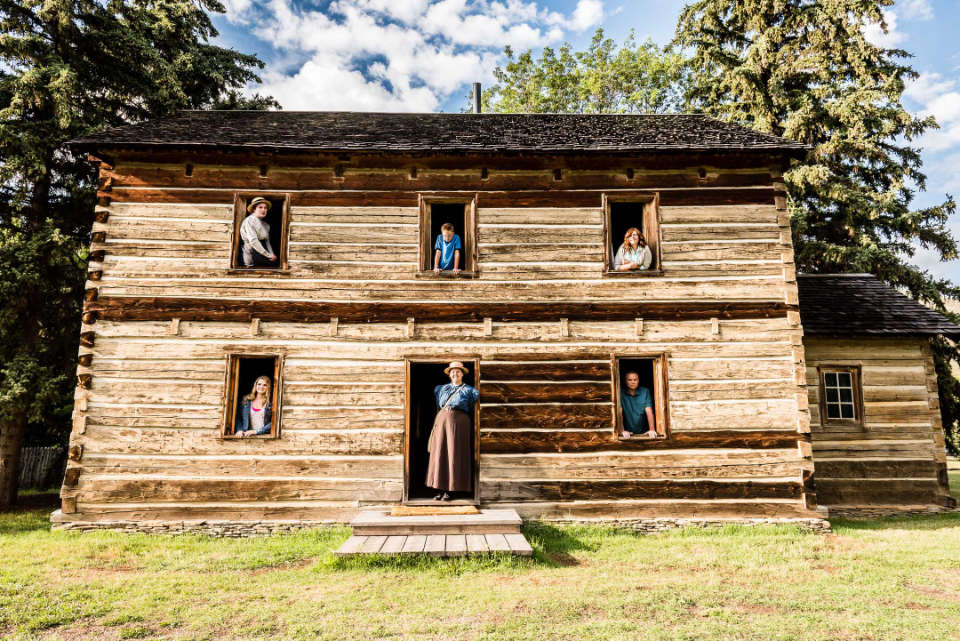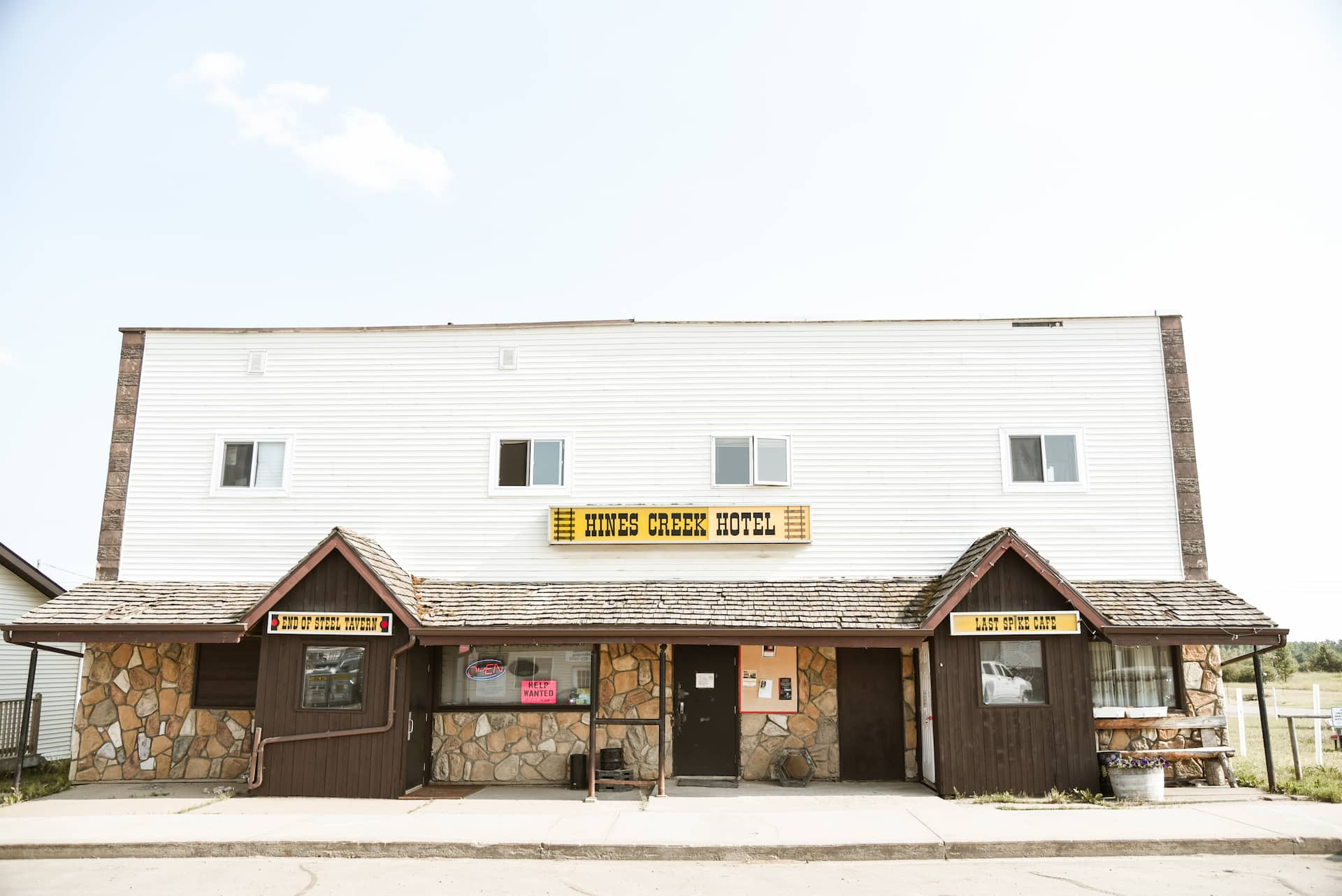Just around the corner – in the shadows, lies Autumn. Or, as we here at Mighty Peace Tourism like to call it, Spooky Season. Ghosts, ghouls, and things that go bump in the night have their share of the spotlight in Halloween themed movies and TV shows. But, did you know that the Mighty Peace area has its own ghostly tales to tell? Mighty Peace Tourism invites you to continue reading for five local stories to get you in the haunting spirit!
Our first stories come from somewhere ranked one of Canada’s most haunted places – Dunvegan Valley. Just 90km North of Grande Prairie, Dunvegan Valley is home to the Historic Dunvegan Provincial Park. Located on the traditional lands of the Tsattine (Beaver) people, the Northwest Company established Fort Dunvegan as a fur trading post in 1805. It was also the site of a Roman Catholic mission, St. Charles; And an Anglican mission, St. Saviour’s.
At the beginning of the 20 th Century, the fur trades posts and missions had closed down. The site was taken care of by locals, including the Knights of Columbus. In its most recent past, market gardens operated in the Valley in the 1940s. Dunvegan was named a Provincial Park in 1956. The ferry service was sacrificed and the Dunvegan suspension bridge was erected in its place. While many of the regions historic buildings are rumored to be haunted, a few stand out for their eerie reputations: Dunvegan Valley, the rectory at Dunvegan, are some of the most infamous in the area. So, grab your blankets, tuck in, and use your flashlights to create some spooky shadows – it’s time for a ghost story!
The Grey Lady of Dunvegan Valley
The Grey Lady of Dunvegan is a figure many have heard of in passing, a spectral presence that lingers faintly in the imagination before vanishing like a wisp of mist. Let’s try to bring her story into clearer focus.
In November 1960, shortly after the bridge’s completion, two men were driving through the snowy, darkened valley. As they cautiously made their way across the bridge, they were shocked to see a woman leaning into the swirling snow, her head hidden beneath a hooded cloak. Despite the warmth of her cloak, her bare feet were exposed to the cold. The men slowed down, hoping to offer assistance, but she didn’t acknowledge them.
Concerned about stopping on the bridge, they continued to the other side and found a place to pull over. One man ventured back through the snow to check on her, calling out as he approached. However, the bridge was empty. Though he had followed their tire tracks through the snow, there were no footprints aside from his own.
Despite the absence of evidence, both men had clearly seen her. Eager to encounter her again, they returned on several nights with friends in tow, focusing their efforts on the bridge.
When they finally saw the figure again, she was further up a hill, seemingly picking berries in the snow. At that moment, they were convinced she was a spirit.
Another account of the Dunvegan Bridge ghost is even more elusive. It is said that a man from Spirit River had a frightening encounter with the ghost woman, but he was so shaken by the experience that he never spoke of it again.
Many descriptions of the ghost depict her more as wearing a nun’s habit than a cloak, leading to her portrayal as a nun. But why would a nun from Dunvegan’s distant past haunt a bridge built in the late 1950s? And why would anyone haunt Dunvegan Bridge, except that it’s a picturesque spot, especially on quiet evenings?
Regardless of belief, in 2015, the Grey Lady helped earn Dunvegan Valley a spot on www.Complex.com ’s list of the 10 Most Haunted Places in Canada (Source:https://www.complex.com/pop-culture/2015/10/10-most-haunted-places-canada/), a designation that has been widely shared since.

The Priest of the Rectory
Another ghostly presence is said to haunt Dunvegan, specifically the historic rectory now part of the Historic Dunvegan Provincial Park tourist site. According to legends, on the very first day the building was open to the public, a visitor experienced retrocognition, a form of knowledge of the past. After picking up a pen from a desk in the bishop’s bedroom on the second floor, she had a vivid vision of the room as it once was, complete with a bearded priest seated at the desk writing a letter.
Many locals speculate that this is the spirit of Alfred Campbell Garrioch, who served as priest of the rectory until 1891. While there were about 11-13 total priests of the church before it was officially closed, Garrioch was the most memorable due to his writings, as he was also an author. He has a book published called “A Hatchet Mark in Duplicate” from 1929, amongst others, that speaks of his time in the Dunvegan area.
Reports from others include seeing lights in the second-floor windows and a priest’s silhouette or feeling a sense of being watched in various spots around the park. Many have tried to capture evidence of Dunvegan’s spirits, but the ghosts seem to be camera-shy (source:https://youtu.be/rccVXXeyqp0 ). Given that Historic Dunvegan houses the second-oldest standing fur trade building still on its original site in Alberta, it’s perhaps fitting that it has a few ghost stories to its name.

Not far from the Dunvegan Valley is the Village of Hines Creek. Settled in the mid-1800s as a trapping location for the North West Company along the Peace River, Hines Creek is named after an early fur buyer, Jack Hines. Two of the local creeks were named by the Indigenous people in his honor, Hines creek of course and Jack Creek. The railroad solidified the townsite’s location in 1930 and was aptly named, Hines Creek. Historically, its also the most North and most West that the Canadian Railway travelled and was referred to as the “End of Steel”.
The Haunted Hotel
One of Hines Creek’s oldest structures, the historic Hines Creek Hotel was originally constructed by Art Pedersen in 1931. Since then, it had undergone numerous changes in ownership and appearance. In July 2017, when Cheryl Lyman and her parents, Albert and Shirley Lyman, took over the property and undertook a significant renovation. The Hotel has since been closed permanently.
During the restoration in, Cheryl often painted late into the night and would hear footsteps from the floor above, despite no one being there. She also reported receiving calls on a non-functioning phone and observed the paper towel motion sensors activating on their own. “There are all sorts of ghost stories here,” she says. As the town’s social hub, the hotel has gathered its fair share of tales, both eerie and otherwise. If you ever visit the Hines Creek area, many locals would be willing to tell you their tales of ghostly encounters.

Cadotte Lake and the Graveyard
Cadotte Lake lies on the border of the Woodland Cree First Nation and Northern Sunrise County, with the Cadotte Lake Metis Nation situated about an hour from Peace River. This region, encompassing Cadotte, Bison, Haig, and Otter Lakes, boasts a deep and storied history. Indigenous peoples have been trading fur here since the early 1800s, and evidence suggests that the area has been inhabited for centuries, featuring seasonal camps and burial sites. The lake was named after a trapper who died nearby.
Locals sometimes share tales of eerie occurrences around the area. They say that walking past the graveyard at night can give you a sensation of being watched, and if you linger after dark, a tall, dark figure might chase you away. Strange lights have also been reported hovering over the lake at night, due to the graveyard’s proximity. Historically, before the community was established, the area was a battlefield, which might explain some of the unusual events reported
today.
Little Girl Ghost
Dr. Annie Ella (Carbeth) Higbee, a pioneering physician and the second medical practitioner to reside among the homesteaders in Northern Alberta, passed away in 1965 at the age of one hundred. In 1912, she journeyed over the Edson Trail with her professor husband and their 13-year-old son, Jack. Dr. Higbee quickly became a well-known figure in the area, traveling on horseback with her medical instruments secured to her saddle, often guided by a lantern carried by a local farmer.
Her nephew recalled how tirelessly she worked, saying, “I used to feel so sorry for her. I was fourteen then, and she hardly had time to rest. She would dash in, grab a quick bite to eat, and then head off again to assist someone. It must have been a grueling life for her.” Despite the demanding nature of her work, Dr. Higbee thrived. She assisted in numerous childbirths, helping to bring many of the pioneers’ children into the world.
“There were so many accidents – many severe – back then,” her nephew noted.
“There were frequent axe wounds and horse-related injuries. She was incredibly busy.”
While Mr. Higbee taught in various rural schools and took up homesteading, Dr. Higbee dedicated herself to serving the pioneers and Cree families in the area. At the time, “Prairie City” was little more than a collection of rough shacks, and her office was one such structure. She navigated through mosquito-infested sloughs or braved the bitter cold to reach isolated cabins and Indian teepees. Her patients included inexperienced homesteaders injured by axes, trappers suffering from pneumonia, and frostbite victims. She pulled teeth, set broken bones, and even taught Indigenous girls how to care for babies with rickets.
After the Higbees moved to the East, Dr. Higbee joined the staff of Toronto Western Hospital and later entered private practice. In 1956, she was honored as the oldest female medical graduate in Canada and the oldest living surgeon on the hospital’s early staff. She later unveiled a plaque commemorating her brother, George Carbeth, one of the founders of the esteemed hospital. Dr. Higbee surely recalled her involvement in laying the cornerstone of the Presbyterian Hospital in Grande Prairie in July 1913, alongside Nurse Baird and Mrs. Forbes, the Presbyterian minister’s wife. Dr. Higbee’s remarkable life spanned a century.
Despite years of dedicated service, Dr. Higbee’s legacy is haunted by a chilling tale beloved by the pioneers—a story that continues to send shivers down the spines of those who hear it. On a snowy evening in 1913, Dr. Higbee had just returned home after a grueling day of deliveries at the reservation. Exhausted, she prepared a light snack and headed to bed, hoping for a few hours of well-deserved rest. But as she was drifting off to sleep, a loud knock reverberated through her cabin. She lay still, hoping it was merely the wind, but the knock came again, more insistent this time.
Reluctantly, Dr. Higbee pulled herself from bed, wrapped her robe tightly around her, and made her way through the cold cabin to answer the door. She was taken aback to find a small child standing in the swirling snow. The girl, dressed in a thin frock and a ragged shawl, was shivering from the cold. They stared at each other for a moment before the girl spoke in a quivering voice,
“My mother is very sick. Will you come, please?”
Dr. Higbee, weary from her long day, hesitated. She suggested that the girl try the Old Pioneer Hospital where Mrs. Forbes and Nurse Baird might help. But the child’s eyes filled with tears as she pleaded, “Please, won’t you come?”
It was impossible to ignore such a desperate plea. With a resigned sigh, Dr. Higbee invited the girl inside while she dressed and prepared her medical bag. The child remained silent, simply motioning for Dr. Higbee to follow her into the storm.
The snow fell relentlessly as they made their way through the night, the little girl leading her to a remote homestead. Inside, Dr. Higbee found a woman lying in bed, feverish and gasping for breath. She recognized the woman immediately and set to work, determined to save her.
As she worked, Dr. Higbee remarked on the girl’s determination to bring her there. The woman’s eyes widened in disbelief. After a moment, she whispered weakly, “That’s impossible. My little girl died over a month ago. Her dress is still hanging in the cupboard over there.”
Dr. Higbee’s heart raced. She slowly approached the cupboard and opened it. There, hanging on a hook, were the little frock and ragged shawl that the child had worn—soaked from the storm. When she turned around, the little girl was nowhere to be found.
Thank you for joining us as we visit the stories of the region that are truly eerie. Do you have any ghostly stories to share from the Peace Region? If you do reach out to us at info@mightypeace.com.
Written by: Lindsay Janes



